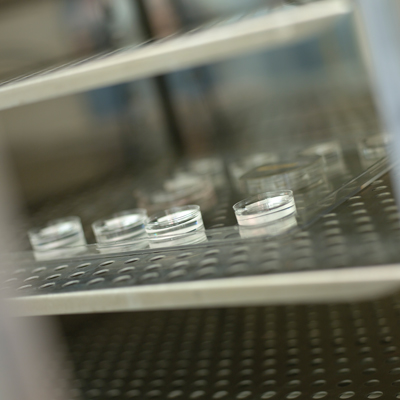When Should A Couple Seek Help?

Generally, if a couple has not conceived within one year of trying, it’s time to consider seeing a fertility specialist. Some couples should seek help sooner, including:
- Women who have irregular or absent menstrual cycles
- Women age 35 and older who have been trying for 6 months.
- Women with a history of endometriosis, pelvic adhesions or pelvic infections
- Women who need to reverse a tubal ligation or have known tubal diseases
- Men with abnormal semen analysis, or erectile or ejaculatory problems
- Men who need surgery to remove blocked tubes (vas deferens or epididymis)
- Men who need microsurgery to reverse a vasectomy or obtain sperm
- Lesbian or single women requiring donor sperm.
Causes
What Causes Infertility?
Infertility can be caused by a number of different factors. In the female, they may include ovulation dysfunction, tubal blockage, endometriosis or structural abnormalities of the uterus such as fibroids. The male partner may have anatomic or hormonal problems that reduce the number and quality of sperm. In many cases, even with the most comprehensive evaluation, no single factor can be identified as the cause. Fortunately, when the cause of infertility cannot be determined, effective treatments are still available.
Diagnosis
How Can Problems Be Diagnosed?
Standard testing includes a semen analysis to assess the number and quality of the sperm. A hysterosalpingogram (HSG) X-ray dye test is performed to evaluate the uterine cavity and the fallopian tubes. The HSG is performed in the X-ray department by injecting dye through the cervix while observing on a monitor to confirm that the cavity of the uterus is normal and both tubes are open.
After thorough consideration of the patient history, physical exam and previous testing, additional tests may be recommended by the fertility specialist. The additional evaluation may include hormone levels, ultrasound of the uterus and ovaries, hysteroscopy and/or laparoscopy.
Laparoscopy is an outpatient procedure that involves placing a thin scope through the navel to diagnose and treat conditions such as endometriosis, pelvic adhesions (scar tissue), ovarian cysts, fibroid tumors and tubal disease.
Treatments

What Treatments Are Available For Infertility?
Treatment options include medical therapy, reproductive surgery, intrauterine insemination and assisted reproductive technologies including in vitro fertilization.
Our Fertility Center’s IVF and research laboratories help improve clinical care and develop cutting edge technology. They feature state-of-the-art equipment for embryo culture, cryopreservation (freezing) and micromanipulation. The IVF lab has 16 incubators, Ohio’s only Embryoscope™ (an incubator that features a built-in camera for continually observing embryos using time-lapse imaging) eight microscope stations, five laminar flow hoods for gamete handling, a laser for assisted hatching and two micromanipulation stations for ICSI or PGD. The culture environment of the embryo is carefully regulated through a specially designed air system.
Medical Therapy
Medical therapy is used to correct ovulation dysfunction (irregular or infrequent periods). If there are no underlying causes of ovulation problems (such as a thyroid disease), the first line of treatment is an oral medication. These drugs may be used to induce regular menstrual cycles.
If oral medication fails to correct the problem, or conception does not occur within six ovulatory cycles, the couple should consider other treatment options.
Gonadotropin therapy is another option for medical therapy. This is effective for inducing ovulation when oral agents do not work. This therapy may also be offered for unexplained infertility or when other factors have been corrected but pregnancy has not occurred. It can enhance fertility by stimulating more than one egg to ovulate during the cycle. It is given as a daily injection, like an insulin shot, for approximately one week. During this time, the patient is monitored with blood tests and ultrasound to optimize timing, reduce the risk of a multiple pregnancy and to prevent over-stimulating the ovaries.
Reproductive Surgery
Surgery is sometimes required to treat conditions associated with infertility. The vast majority of surgical procedures used to address infertility can now be performed on an outpatient basis using a laparoscope (a type of endoscope) inserted through the naval. The surgeon can remove scar tissue, treat endometriosis, remove cysts from the ovaries, remove fibroids and unblock the fallopian tubes. For some patients, an instrument called a hysteroscope may be placed into the uterus through the cervix to remove polyps and fibroid tumors, divide scar tissue and open blocked tubes.
The advantages of these endoscopic procedures include reduced cost, quicker recovery, fewer complications, less pain, better cosmetic results and success rates as good as those performed by laparotomy (open surgery). Cleveland Clinic infertility physicians are internationally recognized for their expertise in laparoscopic treatment and performed the world’s first totally robotic surgery. Laparotomy may still be required for reversing tubal ligations and removing large fibroid tumors, but even these procedures can usually be performed through a small incision as an outpatient.
Intrauterine Insemination
Intrauterine insemination refers to an office procedure in which sperm are removed from the semen fluid and the sperm are then placed into the uterus using a slender plastic catheter inserted through the cervix. Intrauterine insemination may be performed in patients with mildly abnormal semen analyses, as well as those with unexplained infertility in combination with fertility drugs. Intrauterine insemination using anonymous donor sperm is an option in cases when the male partner has severely low or no sperm at all, as well as for single women and lesbian couples.
In Vitro Fertilization
In vitro fertilization (IVF) is a highly successful option for all causes of infertility when conventional treatment has been unsuccessful. It is the primary treatment of choice for couples with irreparable tubal disease or severe male factor infertility.
During the IVF process, the ovaries are stimulated with injectable fertility medications to mature multiple eggs. Once monitoring with ultrasound and blood tests indicate that the eggs are ready, they are collected non-surgically with an ultrasound-guided needle under deep sedation. The egg collection procedure takes about 10 to 15 minutes.
Fertilization is accomplished by exposing the eggs to sperm in a culture dish, or by directly injecting a single sperm into each mature egg (intracytoplasmic sperm injection – ICSI). After fertilization, the embryos are placed in an extended culture. The word "culture," as it is used here, means that we place the embryos in an environment that's similar to what is found in the fallopian tube. Embryos are cultured for 5 to 6 days in order to reach an advanced "blastocyst"stage.
Using the Embryoscope, the development of each embryo is followed continuously. When embryos reach the blastocyst stage, we know just what they look like. However, we also know what they looked like throughout their development. This is important - two embryos that look the same at blastocyst stage, may not always have looked the same throughout their development. These changes and differences, the morphometrics, are monitored continuously. Once they reach the blastocyst stage, embryos are frozen or occasionally transferred to the uterus.
Because of the advances in embryo morphometrics and/or in gene testing, the majority of women transfer just one embryo. This is referred to as "Elective Single Embryo Transfer" or ESET. Any additional embryos that are developing normally may be frozen for future use. The goal we have is to help our patients have one healthy baby at a time.
Egg Donation and Surrogacy
Cleveland Clinic offers both egg donation and gestational carrier services. Egg donation may be considered by those who are unlikely to have success with IVF because the woman does not produce enough healthy eggs. Cleveland Clinic specialists work closely with patients, utilizing all options for obtaining donor eggs including known donors, anonymous donors and donor egg agencies. For women who produce an adequate number of healthy eggs but have no uterus, a damaged uterus or a medical condition that precludes carrying a pregnancy safely, a gestational carrier may be considered. While the technology for both of these programs is readily available, it is essential that couples be comfortable with the use of “third party reproduction” before proceeding with these programs.
Egg and Ovarian Tissue Freezing
Cleveland Clinic’s IVF laboratory is involved in leading-edge research on ovarian tissue and oocyte (egg) freezing. These innovative options are now offered to cancer patients who wish to preserve fertility before undergoing treatments such as radiation and chemotherapy that may cause early menopause. Frozen ovarian tissue can be reimplanted, resulting in the production of new eggs. Eggs can be frozen in much the same way that men bank sperm for later use. While ovarian tissue freezing is still highly experimental, egg freezing has undergone significant improvement and is no longer classified as experimental. Cleveland Clinic infertility specialists have reported many successful pregnancies using frozen eggs.
Preimplantation Diagnosis and Screening
Cleveland Clinic fertility specialists performing IVF are able to use Preimplantation Diagnosis (PGD) and Preimplantation Screening (PGS) to determine that an embryo is genetically normal before pregnancy begins.Using PGD, individuals/couples who are known to be carriers of abnormal genes can reduce their risk of having a baby with the disease. PGS can be used to screen for chromosomal abnormalities in embryos, helping women who are at increased risk for acquired chromosomal errors. Embryos with normal numbers of chromosomes can be selectively transferred, thus increasing the chance of a healthy baby.
The PGD or PGS process requires removal of 5-10 cells from each embryo at the blastocyst stage of development. This is called an embryo biopsy. The cells are analyzed and two days later normal embryos are either transferred to the mother or frozen for future use.
Male Fertility Options

A male factor plays a role in at least 40 percent of infertile couples. For this reason, both the male and female partners should be assessed during a fertility evaluation. Rapid research advances in the area of male reproduction have brought about dramatic changes in the ability to both diagnose and treat male infertility. Cleveland Clinic male fertility specialists, dedicated to understanding and treating men who are unable to initiate pregnancy, are key members of the infertility team.
We offer a full range of services, including evaluation, medical treatment and surgical procedures. The surgical procedures most commonly performed include:
- Microsurgical vasectomy reversal (reversal of sterilization)
- Microsurgical correction of obstruction in the epididymis
- Microsurgical varicocele ligation
- Testicular and epididymal sperm extraction for in vitro fertilization. This procedure allows some men who have no sperm in the ejaculate, and paralyzed men who don’t ejaculate to be able to father a child.
The specialists in the Cleveland Clinic Center for Male Fertility understand your concerns from an emotional perspective as well as the medical one. We offer a unique, comprehensive, team approach to diagnosing and treating male infertility to help you achieve your personal goals and dreams for the future.
For the past 30 years, our state-of-the-art Andrology Laboratory and Reproductive Tissue Bank has been providing the highest quality services to couples being evaluated for infertility. The laboratory features innovative testing using the latest, most effective diagnostic tools and analyses. The laboratory is certified by CLIA in the state of Ohio and accredited since 1994 by the College of American Pathologists (CAP) Reproductive Laboratory Program. The laboratory offers comprehensive semen analysis with a computerized system that allows for the quality of the semen to be thoroughly studied. Other tests include testing to detect antisperm antibodies, oxidative stress and sperm DNA damage. Special stains can be utilized for the presence of sperm in azoospermic specimen. A post-vasectomy screen is available for those patients who have recently had a vasectomy. Services also include the processing of sperm for intrauterine insemination; providing frozen donor semen for artificial insemination; and sperm freezing for patients prior to cancer treatment or vasectomy. Services to freeze ovarian and testicular tissue are available as well.
NextGen Home Sperm Banking
Our NextGen® Home Sperm Banking program allows patients to collect semen samples in the privacy of their home, rather than coming to a fertility lab. Through this novel approach, specimens are shipped in a specially designed chamber to the Cleveland Clinic Main Campus Andrology Laboratory and Reproductive Tissue Bank. The NextGen® Home Sperm Banking kit provides patients a safe and reliable process to store semen samples and preserve their fertility for future.
For more information, please call 866.9BANKIN or 866.922.6546 or visit clevelandclinic.org/nextgen.
Appointments & Locations
Fertility Appointments
Ready to schedule an appointment with one of our fertility specialist?
If you would like to set up a consultation with a Cleveland Clinic fertility specialist, please call 216.444.6601 for a female factor evaluation, or 216.444.5600 for a male factor evaluation. We have locations throughout Northeast Ohio.
Virtual Second Opinion
If you cannot travel to Cleveland Clinic, help is available. You can connect with Cleveland Clinic specialists from any location in the world via a phone, tablet, or computer, eliminating the burden of travel time and other obstacles. If you’re facing a significant medical condition or treatment such as surgery, this program provides virtual access to a Cleveland Clinic physician who will review the diagnosis and treatment plan. Following a comprehensive evaluation of medical records and labs, you’ll receive an educational second opinion from an expert in their medical condition covering diagnosis, treatment options or alternatives as well as recommendations regarding future therapeutic considerations. You’ll also have the unique opportunity to speak with the physician expert directly to address questions or concerns.
Why Choose Us?
Given the intricate nature of the human reproductive system, it’s not surprising that approximately one in every six couples will be unable to conceive a child after trying for one year. Cleveland Clinic fertility experts provide the full range of state-of-the-art services for the diagnosis and treatment of infertility, including in vitro fertilization. Patients are seen in a caring environment, where the major emphasis is not only technological excellence, but also accessibility, personal attention and emotional support.
Our Fertility Lab is accredited by the American College of Pathologists. To learn more about the lab and the safety precautions we employ, as well as our success rates, check out our Fertility Lab FAQ.